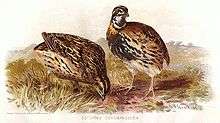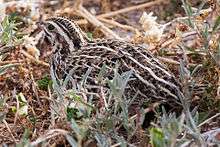Coturnix
Coturnix is a genus of six extant species and five known extinct species of Old World quail.[1] The genus name is the Latin for the common quail.[2]
| Coturnix | |
|---|---|
_(6035291347).jpg) | |
| Harlequin quail, C. delegorguei | |
| Scientific classification | |
| Kingdom: | Animalia |
| Phylum: | Chordata |
| Class: | Aves |
| Order: | Galliformes |
| Family: | Phasianidae |
| Subfamily: | Perdicinae |
| Genus: | Coturnix Garsault, 1764 |
| Species | |
|
See text. | |
These species are distributed throughout Eurasia, Africa, Australia, and formerly New Zealand. An extinct radiation of flightless, insular species is known through fossil remains from Macaronesia, which were likely wiped out by human arrival.
The quails are related to the francolins, jungle bush quail, snowcocks and rock partridges, which together with the species of Coturnix make up a clade called Coturnicinae, a subfamily within the family Phasianidae.
Quail of Coturnix live in pairs or small social groups and form larger groups during migration. Not all species migrate, but most are capable of extremely rapid, upward flight to escape from danger. Unlike related genera, Old World quail do not perch in trees. They devote much of their time to scratching and foraging for seeds and invertebrates on the ground. Typical habitats are dense vegetation such as grasslands, bushes alongside rivers and cereal fields. They are predated upon heavily by the diurnal hawks.
Species
| Extant and recently extinct species | |||
|---|---|---|---|
| Common and binomial names | Image | Description | Range |
| Rain quail (Coturnix coromandelica) |
 |
||
| Harlequin quail (Coturnix delegorguei) |
 |
||
| Common quail (Coturnix coturnix) |
|||
| Japanese quail (Coturnix japonica) |
 |
||
| †New Zealand quail (Coturnix novaezelandiae) |
 |
(extinct) | |
| Stubble quail (Coturnix pectoralis) |
 |
||
| Brown quail (Coturnix ypsilophora) |
 |
||
| Fossil species | |||
|---|---|---|---|
| Common and binomial names | Image | Description | Range |
| †Canary Islands quail (Coturnix gomerae) |
El Hierro, La Palma, Tenerife and Fuerteventura | ||
| †Coturnix alabrevis [1] | Porto Santo Island | ||
| †Coturnix centensis [1] | Cape Verde | ||
| †Coturnix lignorum [1] | Madeira Island | ||
The king quail and blue quail, formerly placed in Coturnix, have been moved to the genus Excalfactoria.
A fossil species from the Late Oligocene - Late Miocene of SW and Central Europe was described as Coturnix gallica. Another, C. donnezani, was widespread in Early Pliocene to Early Pleistocene Europe.[3]
Footnotes
- Rando, Juan C.; Alcover, Josep A.; Pieper, Harald; Olson, Storrs L.; Hernández, C Nayra; López-Jurado, L Felipe (2020). "Unforeseen diversity of quails (Galliformes: Phasianidae: Coturnix) in oceanic islands provided by the fossil record of Macaronesia". Zoological Journal of the Linnean Society. 188 (4): 1296–1317. doi:10.1093/zoolinnean/zlz107.
- Jobling, James A (2010). The Helm Dictionary of Scientific Bird Names. London: Christopher Helm. p. 120. ISBN 978-1-4081-2501-4.
- Mlíkovský (2002)
References
- Mlíkovský, Jirí (2002a): Early Pleistocene birds of Stránská skála, Czech Republic: 2. Absolon's cave. Sylvia 38: 19-28 [English with Czech abstract]. PDF fulltext
- The genetic link between the Chinese bamboo partridge (Bambusicola thoracica) and the chicken and junglefowls of the genus Gallus.A Fumihito, T Miyake, M Takada, S Ohno, and N KondoYamashina Institute for Ornithology, Chiba Prefecture, Japan.
- Phylogenetic analysis of gallinaceous birds inferred from mitochondrial NADH dehydrogenase subunit 5 gene sequences Wee Hui Kit Publisher: 2002.
- A Molecular Phylogeny of the Pheasants and Partridges Suggests That These Lineages Are Not Monophyletic R. T. Kimball,* E. L. Braun,*,† P. W. Zwartjes,* T. M. Crowe,‡,§ and J. D. Ligon*
External links
| Wikimedia Commons has media related to Coturnix. |